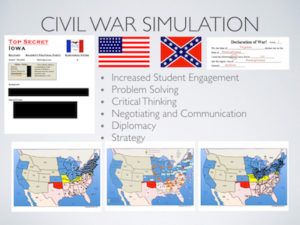Instead of lecturing your students about the American Civil War or showing them another boring PowerPoint, you should consider hands on, Civil War Activities. How much more excited and engaged would your students be if they were participating in history, rather than just learning facts about it. Probably the most important thing to learn about the American Civil War is the reason it started and the circumstances leading up to the first shots being fired on Fort Sumter. With the American Civil War Simulation, your students get to make the critical choices that were faced by Grant and Lee, Lincoln and Davis in the Civil War.
One of the benefits of doing a Civil War Map Activity is how students develop an understanding of where geographic landmarks are and locations of states as well. As kids pour over the maps, they strategize and work within the geographical limitations of their particular situation/state on the map. Constantly working over strategy and developing plans builds a template in their minds as to where things are: oceans, seas and mountains to name a few. This also helps create a relationship to the reasons certain strategies were used in the war.
What really drives simulations like this are the objectives that each student has. Students are playing roles of leaders of states and have to make decisions based on ever-changing circumstances. Because other students in the classroom are trying to achieve the same objectives or stop others from completing their objectives. This interaction between students creates a lot of substantive conversations, not only between students but also with teachers and parents.
The role that natural resources played in the Civil War cannot be overstated. With the Northern states having their own supplies of resources, the Southern States did not have them. This forced the South to get resources from overseas from European countries. Withe the United States Navy firmly in the hands of the Union, a naval blockade will severely cripple the Confederacy’s ability to gain the resources they need. Unlike many Civil War Activities, this one takes the logistics of conducting a war into account. With a Civil War Map Activity, geography plays the role it did in the real War. Access to railroads is another logistical problem that had a huge impact on the war and again a problem the South had to deal with. Inside the Northern territories was vast railroad network linking all the Northern states together. This made the transport of troops, supplies and war materials faster and more efficient. The new, online platform makes the teacher’s job much more streamlined and gives them time to observe and interact with students.
In conclusion, if your looking to get your students engaged, then using Civil War Activities are the way to a more interactive classroom and a dynamic learning environment.

